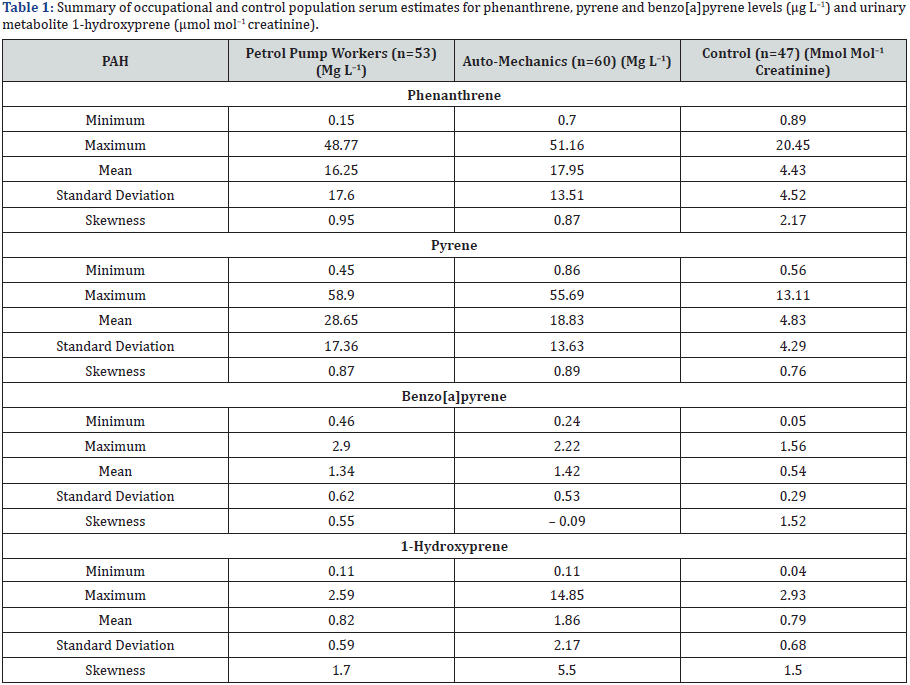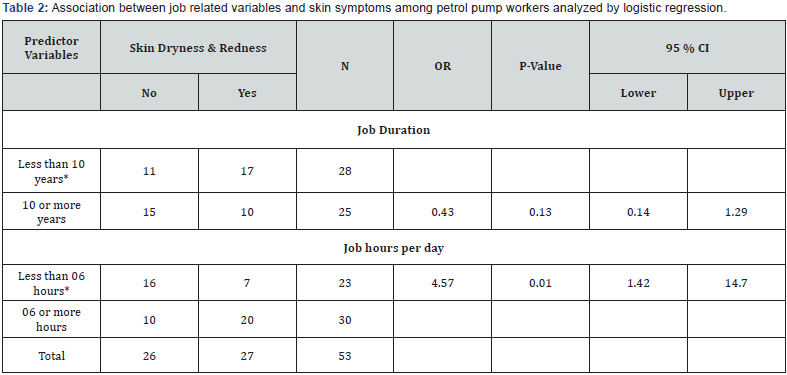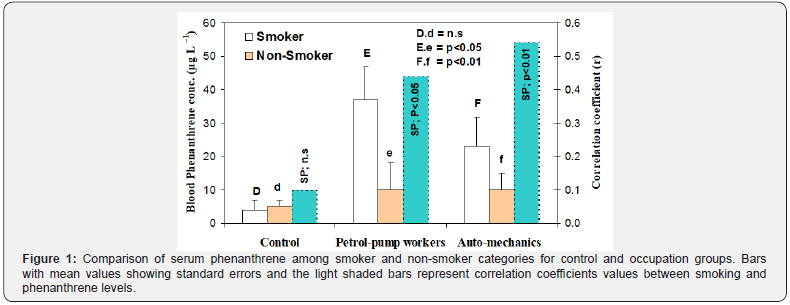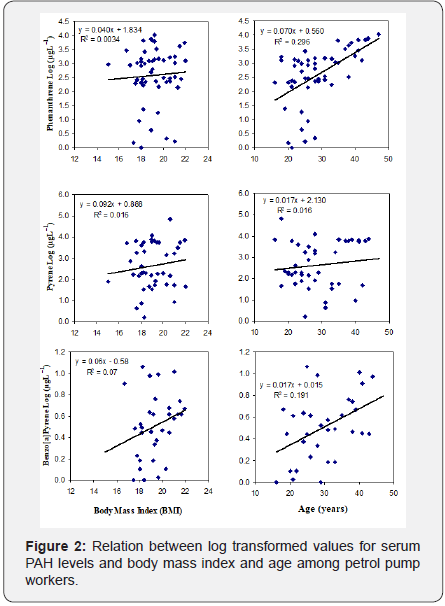Binary Logistic Model for Exposure Assessment to Petroleum Hydrocarbons in Occupational Settings
Faiza Naseem1, Audil Rashid2* and Ikhtiar Ud Din2
1Department of Mathematics, Government Postgraduate College for Women, Pakistan
2Department of Environmental Sciences, PMAS Arid Agriculture University, Pakistan
Submission: July 26, 2018;Published: August 23, 2018
*Corresponding author: Audil Rashid, Eco Health Research Group, Department of Environmental Sciences, PMAS Arid Agriculture University, Rawalpindi 46300, Pakistan
How to cite this article: Faiza Naseem, Audil Rashid, Ikhtiar Ud Din. Binary Logistic Model for Exposure Assessment to Petroleum Hydrocarbons in Occupational Settings. Recent Adv Petrochem Sci. 2018; 5(5): 555674. DOI: 10.19080/RAPSCI.2018.05.555674
Abstract
Exposure to petroleum hydrocarbons in occupational environment is unprecedented especially when health safety protocols are not strictly followed. In this study two occupational setting i.e. auto-mechanic workshops and petrol-filling stations were used as target sites for monitoring exposure to polycyclic hydrocarbons (PAHs) among human workers. Subjects included in the study comprised of 60 auto-mechanics, 53 petro-filling workers and a group of unexposed general population (n=47). We analyzed work conditions, job duration through questionnaire followed by urinary and serum PAH-based biomonitoring to establish effect of exposure on PAH body burden. Results show auto-mechanics highly exposed based on serum (blood) PAH estimates and urinary 1-hydroxyprene concentrations. Significant differences (p<0.01) for these estimates were observed for this occupational group with petrol-pump workers and general urban population. Outcome of binary logistic model (regression based) revealed skin dryness & redness most prevalent among petrol-filling workers who had exposure 6 h day–1 or more (OR=4.57, 95% CI=1.42-14.71) on the other hand, allergic dermatitis shown due to chronic exposure among auto-mechanics when their job duration exceed from 10 years (OR=3.97, 95% CI=1.20-13.14). Emerging correlation between serum phenanthrene levels with smoking habit (r=0.54; p<0.01) further indicates a compounding effect of cigarette smoking in the presence of PAH in occupational settings. We conclude that serum PAH levels are useful proxy measures used as outcome variables in binary logistic model which appears to be a robust approach to predict petroleum hydrocarbon exposure.
Keywords: Polycyclic aromatic hydrocarbons; Exposure assessment; Urine; Serum; Biomarker
Introduction
Human exposure to various types of chemicals in urban environment is unprecedented. In Pakistan, although there is general awareness about harmful effects of such kind of exposure but in depth quantitative research to analyze exposure relation with associated risks is lacking. The environmental degradation in different cities of Pakistan has threatened the urban ecosystem to a great extent because of rising urban population and rural-urban flux of people. Consequently, huge numbers of vehicles are on road in major cities of Pakistan and traffic density is increasing day by day. A rough estimate has shown that on average 500 vehicles are registered daily in Islamabad while this number is around 300 for Rawalpindi city. This rising use of motors and vehicular function has demanded for more auto-mechanic workshops in the cities. The direct effect of this phenomenon was felt in the form of rapid growth in petroleum related occupations both in Rawalpindi and Islamabad areas. Consequently, people associated with such are occupations are believed to suffer more serious health issues compared to other general urban area population. However, the impact urban air pollution and rising human exposure to petroleum contaminants has been the focus of investigation in many developed countries but the same aspect has been neglected to a great extent in under developed countries [1]. The current investigation was planned with an aim to determine blood PAH concentrations in two petroleum related occupational groups to establish exposure effect relation with work conditions and to assess the suitability of selected PAHs as biomarkers. In addition, effort was also made to highlight exposure symptoms particularly physical one such as skin and other dermal problems that are commonly reported by workers during preliminary survey. We assume that the outcome of this research effort would substantially contribute in understanding the status of PAH body burden among occupational cohorts who are involved in petroleum related work and also to set safety guidelines for occupation exposure risks are unavoidable.
Materials and Methods
A detailed preliminary survey of Rawalpindi areas was conducted to select the locations of the petrol filling stations. Similarly, to know where auto-workshops are concentrated, several visits were performed and workers associated with auto-mechanical profession were briefed about the study. Both petrol pump workers and auto-mechanics were requested to involve in the study and after their consent, they were recruited. From each worker, blood sample (3ml) was obtained and procedure for that was followed as described in our previous study [2]. From same worker, urine sample (mid day) was also was collected in 250ml sterilized plastic bottle. A short interview was also conducted to gather information about prevailing health status and any illness that was developed during occupation.
Serum PAH analysis was carried out for three polycyclic aromatic hydrocarbons which comprised of phenanthrene, pyrene and benzo[a]pyrene. For sample preparation and analysis, the method described in [2], was followed and HPLC (Shimadzu) was used for analytical work which ware provided with UV detection. For mobile phase, acetonitrile in varying concentrations along with double de-ionized water. The concentration of PAHs in the serum samples were identified by comparing the time of retention peaks of the standards with that of samples. One urinary metabolite, 1-hydroxyprene was also detected using HPLC. The sample preparation was sample as mentioned for serum estimation. Final calculation was performed by help of following formula [3].

Statistical analyses were performed using SPSS version 16 for Windows®. Description statistics was carried out to reveal basic trends in the data. Mean, median and skewness values were used for this purpose. To predict the presence of exposure illness such as skin problems, binary logistic regression was performed using occupational parameters (job hours per day and job duration in years) as predictor variables. Calculation of regression coefficients was based on maximum likelihood principle through which odds ratio were found for each parameter. A probability level p<0.05 was considered statistically significant.
Result
The concentration of three PAHs detected in two occupational groups show wide ranges. However, the minimum values for control group was found relatively higher for serum phenanthrene estimation than both the occupational groups (Table 1). Among three PAHs detected in two exposure situation, pyrene was estimated in highest amount with 58.9μg L–1 and 55.69 g L–1 in petrol pump workers and auto-mechanics respectively. The mean and median values were close to each other for all the three PAHs (Table 1). Concentration of urinary metabolite i.e. 1-hydroxyprene was found in variable ranges for both the occupational groups as well as unexposed control population. Highest level was detected among auto-mechanics with 14.85μmol mol–1 creatinine followed by 2.59 and 2.93μmol mol–1 creatinine in control group and petrol pump workers respectively (Table 1). The skewness values indicated the normality feature of the data according to which the values obtained for serum phenanthrene, pyrene and benzo[a] pyrene for both the occupational groups had normal distribution whereas urinary metabolite concentration data was not normally distributed for all the cohorts investigated (Table 1).

Results of logistic regression are presented in Table 2 which accounts association between physical symptoms appeared on skin and job related factors such as years involved in particular job category and daily work hours. Although both the predictor variables had odds ratio greater than 1 however, only daily job hours was found significant (OR=3.4; 95%CI=1.07-10.77) (Table 3).


The relationship established between serum PAH levels with BMI and age has clearly indicated a trend of where age appeared to have more positive correlation especially with phenanthrene and benzo[a]pyrene concentrations (Figure 1). The reason age appeared to be good indicator of PAH body burden for petrol pump workers may probably be the nature of job as it demands constant gas filling activity and supervision right at the spot where exposure to volatile PAH compounds is maximum [4]. In addition, the dedication of workers to be associated with one type of job has exerted extra pressure on human body to be readily exposed for longer duration due to which higher PAHs estimates were with increase in age and manifested. Since this factor is more relevant to age rather than BMI therefore, higher regression coefficient values were observed for the former parameter.

Discussion
We found a strong effect of occupational exposure to PAH with allergic dermatitis among auto-mechanics which seems an allergic response of occupational workers to PAHs that has been a neglected research aspect. In some studies only carcinogenicity has been observed with respect to PAH exposure [4-6]. Few studies reported lungs and respiratory diseases attributed to PAHs [7]. However, in few studies allergic response due to PAHs in occupational workers was also observed [1,8]. Therefore, it is assumed that findings of this investigation would further highlight the importance of allergic response as an important health factor to be included in exposure assessment studies.
The urinary metabolite concentration detected in our exposed group has two important implications. Firstly, there seems a definite relationship between nature of petroleum occupation and extent of exposure which was reflected by significantly higher mean values of 1-hydroxyprene in automechanics than petrol pump workers. The other reason implies smoking status as crucial factors causing enhanced PAH exposure among occupational groups that has caused an additive effect on serum pyrene and benzo[a]pyrene levels which was reflected in urinary excretion of 1-hydroxyprene among occupational groups as compared to control population. Although various studies have emphasized on establishing relation between urinary excretion of PAH metabolite with exposure magnitude the findings of general population such as stated by [9] revealed 1-hydropyrene levels can be used as suitable biomarkers of PAHs in urine. Since the males verse females comparison was not valid in our study however, 1-hydroxyprene concentrations in different studies were reported higher in males as compared to general female population. One possible reason for that higher account was due to smoking habit and rate of smoking which is obviously reported higher among male [9,10]. Age factor seems another important aspect in this context which is to be accounted while interpreting urinary biomarker. Since children and young one perform frequent hand-to-mouth activities in daily routine, hence exposure and rate of inhalation from soil and other surfaces contaminated with PAHs may vary with the increase in age and resulting human exposure. Probably this is reason increase in age has reported to have decreasing effect of 1-hydroxyprene concentration [11,12]. Here the distance from emission source has also influenced the PAH body burden with respect to age. Urinary concentrations of 1-hydroxypyrene among children close to emission source had significantly higher body burden than those living farther from the emission source probably which was a coal-fired power plant [11].
In the present investigation, the selection of occupational groups was based on the assumption that petroleum related activities has differential effect on human exposure. For instance, workers at petrol filling stations, mechanics working at automobile workshops, traffic police wardens and professional drivers of buses, trucks, taxis and rickshaws are routinely exposed to PAHs but their exposure varies depending on how they protect themselves. Even highway toll bar attended mainly spend four to eight hours per day on roads with dense traffic. All these occupations, more or less have noticeable exposure which is reflected by variation in PAH serum concentration [13]. From results of serum concentration of three PAHs, it seems that auto-mechanics have highest exposure compared to petrol pump workers. Smoking has significant association with serum phenanthrene levels in both the petrol pump workers and auto-mechanics (Figure 2). The fact that smokers had high significant mean values for serum phenanthrene appeared to be a consequent effect of dual exposure i.e. one from smoking and the other resulting from occupational environment. These observations are further supported by the fact that smoking alone can be a considered an important exposure parameter for PAHs body burden [10]. Similar to our study where petrol pumps workers were involved as occupationally exposure work group, bus drivers was investigated assuming that their daily working hours put them under direct exposure to petroleum hydrocarbon [14]. Smoking and bus driving collectively has been found to cause significant rise in 1-hydroxyprene levels in urine samples when these were compared to control groups [13]. Probably this relation may have played an important role in establishing significant correlation with smoking PAH body burden in both the occupational groups which we have investigated. Although no female population was recruited in this study but reports have clearly indicated the exposure of PAH can have direct effect on urinary metabolite as cooking effect was observed to cause significant rise in urine concentration of 1-hydroxyprene among females [15].

In urban environment, concentration of auto-mechanic workshops and petrol filling stations are potential sources of PAHs emission which can cause contamination of soil [12], ambient air used for breathing of directly exposed population [2]. Location of PAH emission source is crucial and reports have pointed out this aspect as distance effect on overall PAH body burden. For instance, compared to rural area children where traffic density is less, accumulation of PAH among children exposed to more densely populated areas was higher [16]. The present study indicates also accounts this aspect as number vehicles stop and pass at petrol filling stations as well as automechanic workshops and hence the urinary 1-hydroxyprene concentrations along with corresponding benzo[a]pyrene and pyrene values reflect the exposure to emissions relation.
Conclusion
Serum PAH estimates are good proxy measures of petroleum exposure at filling stations and auto workshops. Inhalation and dermal contact are key sources of exposure to PAH in petroleum occupations and can cause severe health risk in long job hour conditions. Yearly health monitoring is imperative to minimize health risks associated with PAH exposure in Pakistan.
Acknowledgement
The authors gratefully acknowledge the funds provided by Higher Education Commission (HEC) of Pakistan to carry out this work under project grant ID 1906.
Author Contribution
The study idea was conceived and planned by AR. Field sampling was conducted by IU and FN. Analytical work was performed simultaneously by AR and IU. Statistical analysis was carried out by AR and FN whereas writing of manuscript and editing was equally performed by all authors.
References
- Kamal A, Naseem R, Fatima MN, Rashid A (2012) Chemical exposure in occupational settings and related health risks: A neglected area of research in Pakistan. Environ Toxic Pharm 34(1): 46-58.
- Kamal A, Qayyum M, Cheema I, Rashid A (2011) Biological Monitoring of Blood Naphthalene Levels as a Marker of Occupational Exposure to PAHs among Auto-Mechanics and Spray Painters in Rawalpindi. BMC Public Health 11: 467.
- Al-Daghri NMA (2008) Serum polycyclic aromatic hydrocarbons among children with and without asthma: correlation to environmental and dietary factors. Intern J Occupational Medicine Environ Health 21(3): 211-217.
- Lisbeth KS, Larkin A, Krueger SK, Bradfeild CA, Waters KM, et al. (2012) Polycyclic aromatic hydrocarbons as skin carcinogens: Comparison of Benzo-pyrene, di benzo-chrysene and three environmental mixtures in the FVB/N mouse. Toxicol App Pharm 264(3): 337-386.
- Van MF, Lantin G, Hoet AC, Lison PD (2010) Childhood leukaemia and parental occupational exposure to pesticides: a systematic review and meta-analysis. Cancer Cause Control 21(6): 787-809.
- Torben N, Hans EJ, Larsenb JC, Poulsenb M (1996) City air pollution of polycyclic aromatic hydrocarbons and other mutagens: occurrence, sources and health effects. Sci Totl Environ 189: 41-49.
- Maliszewska KB (1999) Sources concentrations fate and effects of polycyclic aromatic hydrocarbons (PAHs) in the environment. Part A: PAHs in Air. J Environ Science 8(3): 131-136.
- Sania A, Bollinger ME (2004) Latex allergy and occupational asthma in health care workers: Adverse outcomes. Environ Health Perspective 112(3): 378-381.
- Sul D, Ahn R, Im H, Oh E, Kim JH, et al. (2012) Korea National Survey for Environmental Pollutants in the human body 2008: 1-hydroxypyrene, 2-naphthol, and cotinine in urine of the Korean population. Environ Res 118: 25-30.
- Lai CH, Liou SH, Shih TS, Tsai PJ, Chen HL, et al. (2004) Urinary 1-hydroxypyrene-glucuronide as a biomarker of exposure to various vehicle exhausts among highway toll-station workers in Taipei, Taiwan. Arch Environ Health 59(2): 61-69.
- Hu SW, Chan YJ, Hsu HT, Wu KY, Chang CGP, et al. (2011) Urinary levels of 1-hydroxypyrene in children residing near a coal-fired power plant. Environ Res 111(8): 1185-1191.
- Din IU, Rashid A, Mahmood T, Khalid A (2013) Effect of land use activities on PAH contamination in urban soils of Rawalpindi and Islamabad, Pakistan. Environ Monitor Assess 185(10): 8685-8694.
- Petchpoung K, Kaojarern S, Yoovathaworn K, Sora T, Sirivarasai J, et al. (2011) The influence of metabolic gene polymorphisms on urinary 1-hydroxypyrene concentration in Thai bus drivers. Environ Toxicol Phar 31(1): 160-164.
- Perng JT, Shih TS, Chen HL, Lee WJ, Lia CH, et al. (2004) Assessing and predicting the exposures of polycyclic aromatic hydrocarbons (PAHs) and their carcinogenic potencies from vehicle engine exhaust to highway toll station workers. Atmos Environ 38: 333-343.
- Chen B, Hu Y, Jin T, Zheng L, Wang Q, et al. (2007) Higher urinary 1-hydroxypyrene concentration is associated with cooking practice in a Chinese population. Toxicol Letters 171(3): 119-125.
- Freire C, Abril A, Ramos R, Estarlich M, Manrique A, et al. (2009) Urinary 1-hydroxypyrene and PAH exposure in 4-year-old Spanish children. Science Total Environ 407(5): 1562-1569.






























